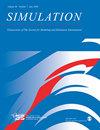面向实时仿真的定向井钻柱动力学建模
IF 2
4区 工程技术
Q4 COMPUTER SCIENCE, INTERDISCIPLINARY APPLICATIONS
Simulation-Transactions of the Society for Modeling and Simulation International
Pub Date : 2023-06-16
DOI:10.1177/00375497231175927
引用次数: 0
摘要
简单且计算效率高的钻柱模型可以实时描述定向井中所有轴向的运动,这对于在钻井过程中实现闭环控制和辅助监测非常重要。本文提出了一种新的基于参数曲线和集总参数建模的简化三维模型,其中采用凯恩法建立运动方程。通过与有限元模型的比较,验证了集总模型在垂直和水平方向上的稳态运动和收敛性。与有限元分析相比较,得到了较好的构形和恢复力分析结果。因此,该模型表明轴向收缩是物体恢复力面向惯性系的函数,固有地产生非线性耦合轴向拉力。该模型的定性响应在模拟案例研究中得到了证实,并以斜度j井配置为例进行了展示。移动块速度和顶部驱动扭矩作为驱动输入,用于分析沿井筒的井底摩擦和接触。该模型可作为定向井钻井的虚拟传感器。本文章由计算机程序翻译,如有差异,请以英文原文为准。
Modeling of drill string dynamics in directional wells for real-time simulation
Simple and computationally efficient drill string models running real-time describing motion in all axes in directional wells are important for the implementation of closed-loop control and assisted monitoring during drilling operations. This paper proposes a new simplified three-dimensional model based on a parametric curve and lumped-parameter modeling, where Kane’s method is used to establish the equations of motion. Validation of the steady-state motion and convergence for the lumped model in vertical and horizontal alignment was compared with a finite-element model. The configuration and restoring forces show good results compared with finite-element analysis. Hence, the model demonstrate the axial contraction as a function of the body restoring forces being oriented to the inertial frame, inherently producing nonlinear coupled axial tension forces. The qualitative response of the model is confirmed in simulation case studies, being showcased by a deviated J-well configuration. Traveling block velocity and top drive torque are included as actuated inputs to analyze off-bottom friction and contact along the wellbore. The model is proposed to act as a virtual sensor for drilling directional wells.
求助全文
通过发布文献求助,成功后即可免费获取论文全文。
去求助
来源期刊
CiteScore
3.50
自引率
31.20%
发文量
60
审稿时长
3 months
期刊介绍:
SIMULATION is a peer-reviewed journal, which covers subjects including the modelling and simulation of: computer networking and communications, high performance computers, real-time systems, mobile and intelligent agents, simulation software, and language design, system engineering and design, aerospace, traffic systems, microelectronics, robotics, mechatronics, and air traffic and chemistry, physics, biology, medicine, biomedicine, sociology, and cognition.

 求助内容:
求助内容: 应助结果提醒方式:
应助结果提醒方式:


